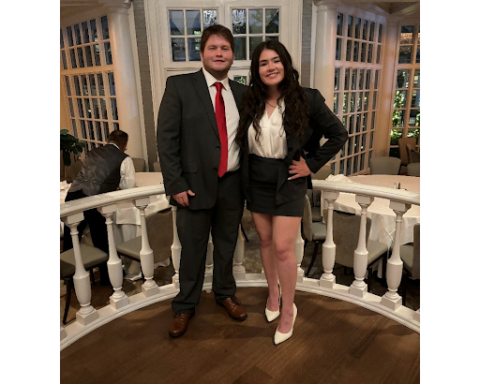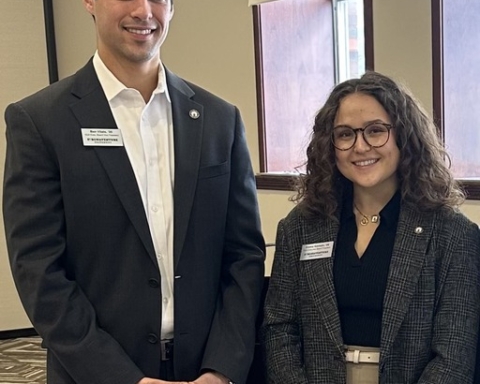By Hannah Gordon
Assistant News Editor
On Tuesday, Sept. 24, Sister Margaret Carney, O.S.F. and university president, addressed the Class of 2017 in the Dresser Auditorium. I expected a generic speech somehow connected to the All Bonaventure Reads book, “Full Body Burden: Growing Up in the Nuclear Shadow of Rockey Flats,” by Kristen Iversen. However, Sister Margaret delivered an emotional roller coaster.
Before she began, I hoped her presentation would be short. However, once she started with “I’d like to invite you to a funeral. The funeral of my step-sister, Marianne,” my heart immediately broke, and I couldn’t wait to listen to Sister Margaret’s story. She displayed a picture of her step-sister on the projection screen, a picture of a young, beautiful, happy girl, and she began her story.
Throughout the speech, Sister Margaret recalled the life and death of her step-sister. She portrayed Marianne as independent and artistic.
“No one ever told her what to wear or how to behave,” Sister Margaret said. “She wasn’t bad, she was just independent.”
At one point, Sister Margaret held up a vase that held a candle. It was sitting on a table next to her the entire time. At first, I didn’t think it was anything more important than a tool to set the mood for a reflective experience.
“One of the talents that she discovered in high school and went on to perfect in college was art,” Sister Margaret said. “She was a tremendous artist. Part of my evocation of the funeral is this vase, which she made.”
Just as I began to wonder when the connection to “Full Body Burden” would come into play, Sister Margaret began to explain the sudden change of events in Marianne’s life. She had a miscarriage, which sadly is common in first pregnancies.
“Shortly after that, though, she began to have symptoms. She would bruise if she just touched something,” Sister Margaret said.
When Marianne was finally diagnosed, the doctor’s told her she had aplastic anemia, a condition in which the bone marrow does not make enough new blood cells. Marianne had to undergo extensive chemotherapy and needed a bone marrow transplant, according to Sister Margaret. This hit home with me, as I just lost my godfather, also at a young age, who had battled many diseases in his life.
Eventually, the family found a bone marrow match in Sister Margaret’s younger sister, Lisa, and the procedure took place. Marianne began to get better. I found myself hopeful at this point, but the candle burning in the vase reminded me that this story did not end happily, and that it was still connected to nuclear radiation.
In the summer of the following year, the bruising, weakness and suppressed immune system returned.
“In the first week of November, the doctor asked the entire family to sit down in the conference room and told us that there was nothing more that could be done and that she would most likely not survive the next four weeks,” Sister Margaret said.
At that moment, I cried. I felt the pain of knowing the loss of a loved one was coming.
On the morning of Dec. 1, Marianne passed away. She was buried in her wedding dress that she wore just two years before.
Sister Margaret and her family sat down with the doctors to determine what could’ve caused the destruction of her vigorous and athletic stepsister’s body.
“One of the things that came out in the analysis was when she and her husband moved to that beautiful country house is that they were downhill from a toxic waste industrial dump,” Sister Margaret explained.
Most likely, the pure well water that Marianne and her husband, Bill, thought that they were getting to keep them healthy was contaminated with toxic wastes from the dump.
“We were not as brave as the people you read about in Iversen’s book who went out and protested, created law suits and demanded investigations,” Sister Margaret confessed. This directly connected to the last line of “Full Body Burden,” “To speak out or to remain silent is the first and most crucial decision we can make.”
Sister Margaret then concluded her speech.
“I say to you right now, that was given to us as a very possible reason that was the cause of her illness. But at the time of her death, Bill was so heartbroken and, as the next of kin, unwilling to pursue a law suit or investigation, we never found out for certain if that was the cause. Yet, knowing how healthy she was, I have always believed that it was,” she said.
Sister Margaret blew out the candle. It signified the end and the audience erupted in applause. It was impossible not to feel the raw emotion radiating in the room.
On behalf of the Class of 2017, thank you, Sister Margaret, for creating that incredibly personal and moving connection with us.
gordonhr13@bonaventure.edu





